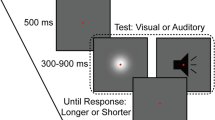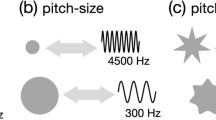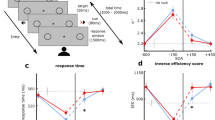Abstract
Previous evidence suggests that people “hear” visual stimuli when encoding temporal information. This suggestion is based on the observation that auditory distractor information can strongly affect discrimination performance for visual temporal sequences. The present study aimed to replicate and extend this finding by investigating sequence discrimination within and across the two modalities. In two experimental series, participants judged whether two subsequently presented temporal sequences, a standard sequence followed by a comparison sequence, were identical or not. In Experimental Series A, irrelevant distractor information was presented simultaneously with the standard sequence. In Series B, the distraction appeared in the retention interval between the standard sequence and the comparison sequence. The results showed that auditory distraction impaired performance irrespective of whether the target sequences were auditory or visual, whereas visual distraction only impaired the discrimination of visual target sequences. Furthermore, auditory distraction was always at least as effective as visual distraction, irrespective of standard modality. Generally, discrimination performance was much better for auditory than for visual sequences. Overall, the present results are consistent with the idea that people code visual temporal information in the auditory modality. Moreover, the present study also suggests that such cross-modal interference effects should be interpreted cautiously with respect to their underlying timing mechanism because of the basic differences in temporal sensitivity between the two modalities.



Similar content being viewed by others
Notes
A potentially stronger effect of visual distraction with prolonged frame duration was suggested by a pilot experiment (N=10), which explored visual and auditory sequence discrimination without distraction. This experiment showed an improvement of discrimination performance with a prolonged frame duration (100 vs. 140 ms) only for visual sequences.
In the results section of their Experiment 1, Guttman et al. (2005) refer to the results of a follow-up experiment, in which participants discriminated auditory sequences (in isolation, with congruent visual information, or with incongruent visual information) with an average accuracy of 94.6% correct.
References
Bausenhart KM, de la Rosa MD, Ulrich R (2014) Multimodal integration of time: visual and auditory contributions to perceived duration and sensitivity. Exp Psychol 61:310–322
Brainard DH (1997) The psychophysics toolbox. Spat Vis 10:433–436
Bratzke D, Seifried T, Ulrich R (2012) Perceptual learning in temporal discrimination: asymmetric cross-modal transfer from audition to vision. Exp Brain Res 221:205–210
Bratzke D, Schröter H, Ulrich R (2014) The role of consolidation for perceptual learning in temporal discrimination within and across modalities. Acta Psychol 147:75–79
Bratzke D, Quinn KR, Ulrich R, Bausenhart KM (2016) Representations of temporal information in short-term memory: are they modality-specific? Acta Psychol 170:163–167
Burr D, Banks MS, Morrone MC (2009) Auditory dominance over vision in the perception of interval duration. Exp Brain Res 198:49–57
Chen L, Zhou X (2014) Fast transfer of crossmodal time interval training. Exp Brain Res 232:1855–1864
Coltheart M (1980) Iconic memory and visible persistence. Percept Psychophys 27:183–228
Cowan N, Aaronson D, Glanzer M, Balota D, Clifton R, Pollatsek A, Crowder R (1984) On short and long auditory stores. Psychol Bull 96:341–370
Fendrich R, Corballis PM (2001) The temporal cross-capture of audition and vision. Percept Psychophys 63:719–725
Glenberg AM, Mann S, Altman L, Forman T, Procise S (1989) Modality effects in the coding and reproduction of rhythms. Mem Cogn 17:373–383
Grahn JA (2012) See what I hear? Beat perception in auditory and visual rhythms. Exp Brain Res 220:51–61
Grondin S (1993) Duration discrimination of empty and filled intervals marked by auditory and visual signals. Percept Psychophys 54:383–394
Grondin S, Ulrich R (2011) Duration discrimination performance: no cross-modal transfer from audition to vision even after massive perceptual learning. In: Vatakis A, Esposito E, Giagkou M, Cummins F, Papadelis G (eds) Multidisciplinary aspects of time and time perception, vol 6789. LNAI. Springer, Berlin, pp 92–100
Guttman SE, Gilroy LA, Blake R (2005) Hearing what the eyes see: auditory encoding of visual temporal sequences. Psychol Sci 16:228–235
Kanai R, Lloyd H, Bueti D, Walsh V (2011) Modality-independent role of the primary auditory cortex in time estimation. Exp Brain Res 209:465–471
Kleiner M, Brainard DH, Pelli D (2007) What’s new in psychtoolbox-3? Perception, 36 ECVP Abstract Supplement
Lapid E, Ulrich R, Rammsayer T (2009) Perceptual learning in auditory temporal discrimination: no evidence for a cross-modal transfer to the visual modality. Psychon Bull Rev 16:382–389
McAuley JD, Henry MJ (2010) Modality effects in rhythm processing: auditory encoding of visual rhythms is neither obligatory nor automatic. Atten Percept Perform 72:1377–1389
Morey R (2008) Confidence intervals from normalized data: a correction to Cousineau (2005). Tutor Quant Methods Psychol 4:61–64
Ortega L, Guzman-Martinez E, Grabowecky M, Suzuki S (2014) Audition dominates vision in duration perception irrespective of salience, attention, and temporal discriminability. Atten Percept Psychophys 76:1485–1502
Pelli D (1997) The VideoToolbox software for visual psychophysics: transforming numbers into movies. Spat Vis 4:437–442
Rattat AC, Picard D (2012) Short-term memory for auditory and visual durations: evidence for selective interference effects. Psychol Res 76:32–40
Repp BH, Penel A (2002) Auditory dominance in temporal processing: new evidence from synchronization with simultaneous visual and auditory sequences. J Exp Psychol Hum Percept Perform 28:1085–1099
Ulrich R, Nitschke J, Rammsayer T (2006) Crossmodal temporal discrimination: assessing the predictions of a general pacemaker-counter model. Percept Psychophys 68:1140–1152
Welch RB, Warren DH (1980) Immediate perceptual response to intersensory discrepancy. Psychol Bull 88:638–667
Acknowledgements
We thank Karolin Schuh for her assistance with data collection. This work was supported by a grant from the Deutsche Forschungsgemeinschaft (UL 116/14-1).
Author information
Authors and Affiliations
Corresponding author
Additional information
Publisher's Note
Springer Nature remains neutral with regard to jurisdictional claims in published maps and institutional affiliations.
Rights and permissions
About this article
Cite this article
Bratzke, D., Ulrich, R. Temporal sequence discrimination within and across senses: do we really hear what we see?. Exp Brain Res 237, 3089–3098 (2019). https://doi.org/10.1007/s00221-019-05654-4
Received:
Accepted:
Published:
Issue Date:
DOI: https://doi.org/10.1007/s00221-019-05654-4




